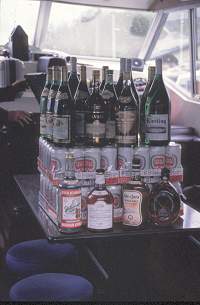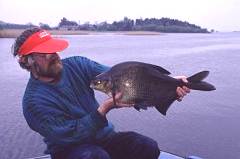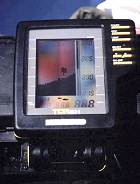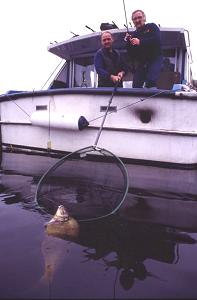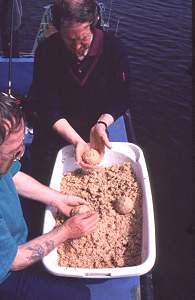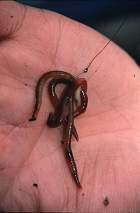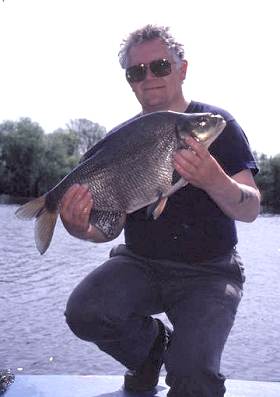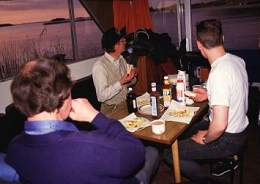Andrew ‘Windy’ Miller extolled the virtues of pike fishing from a cruiser on Norfolk’s river Yare in the news on this website recently (see link below).
|
|
| |
Advantages of a cruiser
A cruiser offers comfortable accommodation with all the mod-cons you would expect to find in a well fitted-out caravan, including hot and cold water, flush toilet, shower, kitchen with full stove, fridge and all necessary utensils. There is a heated (if you need it) lounge area, and en-suite sleeping berths with bedding. Then there are the items you wouldn’t find in a caravan, which are: buoyancy aids, navigation charts, binoculars, and a distress flag to hang over the side if you break down or need assistance for any reason.
A cruiser enables you to reach the parts other anglers cannot reach! You can fish any part of a water, no matter how far from the margins, providing there are no rocks and the water is deep enough. Considering the draft of most cruisers is about one metre that means you can cover a lot of water. This same advantage also means you need never be more than a float cast from any swim, so offering you a comprehensive choice of methods.
|
|
| |
You tackle up any rod only once, and then place it on the roof of the cruiser, where it lies waiting to be chosen any time you want to use that rod for the duration of your holiday. In fact all your tackle is always little more than an arm’s length away, ready and waiting to be used with the minimum of fuss. So there is no tackling and untackling to be done between the first day and the last of your visit, and probably the most enjoyable part of that is being able to fall out of bed in the morning and be casting in within five minutes, having walked no more than a few yards.
You cast in, turn round and put the kettle on the stove for a fresh brew, take your two paracetamol to take care of the night before, and you’re ready to face another day bagging up and chilling out. All through the day a fresh drink (of any kind) is readily available, as is a bed, a snack, a hot meal, or just a relaxing hour or so with a book, the radio, or the T.V. (which we take with us) while you rest your rod arm.
|
|
| |
Another advantage is that cruising is enjoyable in its own right, and you can have a day, or part of a day, away from the fishing if you wish, pulling into a mooring where there is a bar, bar snacks, and probably a restaurant, for a lunch or an evening meal and while away a few hours in good style. Before darkness falls you can then cruise over to your chosen swim and get moored up and baited up ready for the following morning’s assault on the bream, or whatever species you fancy. There are no police (Garda) cruising the lough or river waiting to breathalyse you, but just make sure you stay well capable of handling the cruiser!
There is no doubt a cruiser makes for a very pleasant, easy, relaxing and comfortable way to fish. And there is no need to worry about driving a cruiser for the first time, for you’ll be given a few lessons at the marina, and in no time at all you’ll wonder what you were worrying about.
|
|
| on the sonar |
The Disadvantages
Like any holiday, particularly a fishing one, a cruiser holiday is at the mercy of the weather. Rain is hardly a problem, in that you can easily keep dry and warm while fishing. Wind is the real problem, for heavy winds can prevent you from mooring in some open-water swims, and when the big loughs are really rough it isn’t wise to cross them. Also, after a few days of being on a cruiser that is rolling more than usual in the waves and swell, it can get to you, and you may not always be moored close to land where you can get away from it for a while.
You need to be with a few good mates to stick a week or more on a cruiser, for when you spend several days in such relatively cramped quarters you can get on each others nerves if one or two are awkward, argumentative, or untidy and you’re falling over tackle and clothes all the time.
|
|
| |
Breakdowns can be a pain, specially if you break down in out-of-the-way areas, where few other cruisers pass and you can’t get a message to your marina. But having said that we have broke down very few times in all the years we’ve taken cruiser holidays, and fortunately never anywhere where we couldn’t get help fairly quickly. But if you choose your cruiser company wisely you are not likely to break down. Also, in these days of mobile phones you can get help pretty quickly.
In spite of the few disadvantages I’ve noted above, there has been only one cruiser holiday we’ve taken that we were less than happy with, when the rain pelted down and the wind howled practically all week. And even then, when we settled for some solid moorings, although the fishing wasn’t as good, it turned out okay. That’s not a bad record considering we’ve hired a cruiser once or twice every year for more than ten years.
Choosing a Cruiser
Always hire a cruiser that is at least one berth larger than the number of anglers using it. For instance, there are usually four or five of us, and we hire a six-berth. Four on a six-berth, or two on a four-berth, is ideal. What you have to allow for is all the tackle, for much of it can go in the spare berth(s) out of the way. Without at least one spare berth it is a real struggle, and you simply don’t have enough room.
|
|
| |
Choose a cruiser that has a good well at the stern to fish from. Some cruisers are just not suitable at all. Prices vary according to season, but you could get a better deal if you book through an angling tour operator such as Leisure Angling.
Stowing the Tackle and Bait
All the rods, landing nets and holdalls go on the roof and are tied down when we are on the move. Keepnets go on the nose and are weighted down. Any other tackle that is smelly, or can stand staying outside goes in the well, and rucksacks, tackle boxes, and the like, go in the lounge area, or in the spare berth. Baits and groundbaits not in immediate use are stored in waterproof tubs and bags in the riverboat, or on the nose if the riverboat is in use.
|
|
| worm/maggot cocktail |
Each man has a Job
Organising yourself properly makes you efficient and prevents arguments. There should be a driver (and at least one other man who can take over if necessary), two men who deal with the ropes, mudweights and anchor when mooring, and if there is anyone else, they should soak stale bread, mix groundbait, and bait the swims. Who prepares the meals, who washes up, and when, should also be decided and agreed beforehand. It may all seem a little regimental, but believe me, it can save a lot of arguing at the end of the day.
Mooring a Cruiser
It’s easy – once you know what you’re doing and have the confidence to do it. Most of the places you’ll fish from will be in, or close to, navigation areas, which will be well marked as far as shallow water and rocks are concerned. It’s the other, out-of-the-way spots where you have to be extra careful not to bottom in shallow water, or strike a rock that lies just below the surface. The safest way is for two or three of your party to find the route in the river boat (supplied with every cruiser) to where you want to fish. If you have an echo sounder it makes it so much easier. Although two good men with sharp eyes and a pole each is almost as good. It’s a lot easier than it seems, for all you’re looking for is a clear, 4ft-plus deep channel, wide enough for the cruiser to go through.
|
|
| |
Once the cruiser is in position, with the nose into the bank (or rushes) and the stern facing the swim, the nose is roped to a tree or boulder (if it’s the bank) or the anchor thrown into the rushes.
Now the important bit. A concrete block, weighing at least 30lb, is lowered on ropes from each corner of the stern into the water and tied off. These prevent the stern from swinging from one side to the other, which it will do if only the nose is secured. We have two concrete blocks at the marina which we pick up each visit. Alternatively, if you can lay your hands on any, you can use two long scaffolding poles where the bottom is soft enough for them to be stuck in.
The next job is to secure the river boat side-on to the cruiser, tying the nose of the river boat to the cruiser and anchoring, with mud-weights, the stern of the river boat. This gives you the stern of the cruiser and the full length of the river boat to fish from. We have occasionally taken a flat-bottomed punt with us to fish from
Catching Fish
A great advantage of the cruiser when trying to locate fish is that you can sit in great comfort in the cruiser in the evenings, and into darkness, out on the lough, with a glass of Irish whiskey, or other suitable beverage, and simply watch. Irish bream are specially prone to that breamy habit of rolling, and it won’t be long before you spot them. Favourite areas to fish are where the reedbeds form a point, for the lough bed usually follows the same contour, the peak and the shelves each side of the promontory making for good feeding grounds.
|
|
| for the rudd to show up |
Whatever we fish for, apart from pike, we have found the best way to ensure we catch fish is to bait the swim in the evening, even if we don’t intend fishing until the following morning. This is particularly relevant when bream are the target, which most often they are. We soak stale bread and stiffen it with breadcrumb, lacing it with maggots and sweetcorn. A baby-bathful of this is thrown into an area the combined length of the cruiser stern and river boat, within the distance a catapult can fire maggots. From that moment on, whether it be the same evening, or the following morning, only loose feed is used. A swim (or swims) is baited every evening in this way, except that the amount is reduced by about half if the swim has received bait previously. We have had some massive catches of bream, hybrids, rudd and roach, many of them topping 1000lb, so we can’t be doing a lot wrong.
|
|
| |
Quivertip rods using a block-end swimfeeder are favourite when legering, and straight wagglers, or Locslide floats for float fishing. You rarely need anything fancy, for if you’ve baited up in the right swim the bream, especially, are ridiculously easy to catch. I particularly enjoy fishing with a Starlite float in the evenings for rudd, using a slow-sinking bunch of maggots, or a grain or two of corn, or pinch of flake.
Pike fishing is made very easy with a cruiser in that you can anchor in large areas of open water, with your back to the wind, and deliver a driftfloat over many different tracks. Trolling is a piece of cake, and straightforward legering no problem. You simply stick your rods on a pod in the well, or on the nose, or even on the roof, clip up to drop-off alarms, and relax.
You’re going to have to try it to know just how good it can be. And it is very, very good. I shall be there again next year.











